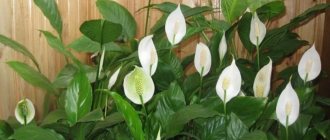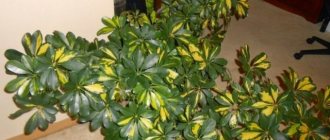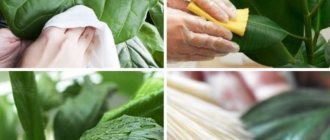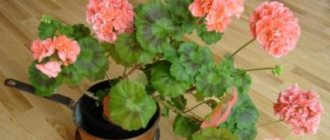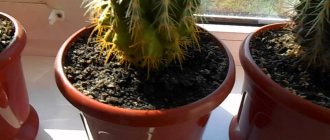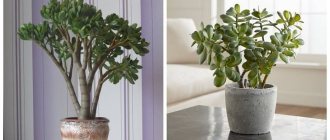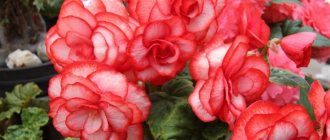What does a monstera look like?
The monstera plant is native to the tropical forests of South and Central America. In its natural environment, it can grow up to 50 m in length. At home, the largest specimens do not exceed 6 m.
The leaves of the vine are leathery and grow on large petioles. The characteristic color is dark green. But there are also variegated varieties.
The young monstera has solid leaf blades. Over time, holes appear on them. An adult leaf takes on a characteristic carved shape.
The largest leaves reach 1 m in length and half a meter in width.
Monstera produces 2-3 leaves per year. When young leaves reach a certain size, the growth of the vine stops and the formation of aerial horses begins.
After this, the plant produces a few more leaves, then slows growth again to gain mass of aerial roots.
What types of monstera are popular?
In total there are over 50 species of this vine.
Monstera Deliciosa, Delicious or Attractive (Monstera deliciosa) at home grows no longer than 3 meters. The leaves are dark green and resemble elongated hearts.
Monstera Adansonii (Monstera adansonii) or Perforated can grow up to 8 m. The leaves are shaped like an egg. The plates are dotted with small holes.
Monstera Obliqae or Monstera Obliqae is characterized by small (no more than 20 cm in length) leaves. The plates are oval-shaped, asymmetrical.
Monstera friedrichsthalii is sometimes classified as a separate species. But more often it is called a subspecies of Monstera Adanson or Monstera Oblique. Outwardly, it looks more like the first one.
Thanks to the efforts of breeders, variegated (variegated) varieties of monstera have been developed:
- Monstera Alba is distinguished by white spots on the leaves and stem; they can occupy up to half the area of the leaf plate;
- Monstera Marble combines yellow and green colors;
- Monstera Borziga has smaller leaves (about 30 cm), another difference from Monstera Deliciosa is thinner stems.
Monstera Minima has a sparse crown and is well suited for growing as an hanging plant.
One of the rarest varieties is the thin monstera (Monstera tenuis). A distinctive feature is that the leaves on one plant differ not only in length and width, but also in shape.
The Monkey Leaf variety has elongated leaves. They are not dissected, but have wide slits.
Photos and names of other interesting monstera species can be seen in the video below.
How to care for monstera
The house flower Monstera is loved for its unpretentiousness. The plant is easily satisfied even with artificial light and does not require extreme wintering conditions.
Lighting
For monstera, prolonged exposure to direct sunlight and deep shade are equally destructive.
The best lighting for her is bright diffused light or partial shade. The optimal length of daylight is 12 hours.
For this vine there is no difference between natural and artificial lighting. It grows well under lamps.
A signal that the monstera does not have enough light will be smaller leaves without openwork cuts.
Signs of sunburn are pale leaves covered with yellow spots.
Location
Monstera is placed not on the windowsill, but on a stand. The flower is placed near windows facing west or east. If the windows face south, it is better to move the pot deeper into the room.
Monstera does not tolerate frequent movements.
Therefore, it is recommended to think in advance about a place where the overgrown vine will not interfere. They also take into account that over time it will need supports.
The flower should not be placed where it will be exposed to cold air from an air conditioner or from a window when ventilating. In addition, it should not be located close to the radiator or heaters.
Temperature
Like all indoor flowers, monstera does not tolerate drafts and sudden changes in temperature.
Monstera prefers moderate temperatures:
- 20-25°C in summer;
- 18-20°C in winter.
At temperatures below 15°C the vine stops growing, below 10°C it dies.
The hotter the room, the faster the monstera grows.
But to prevent it from suffering from overheating, you will need to increase the humidity.
Monstera does not have a pronounced dormant period. But it is recommended to let it rest at a low temperature for at least a month.
Humidity and spraying
For health, Monstera requires a humidity of more than 60%. It is supported by spraying the air or the plant itself.
It is recommended to do this on average once every 2 days. If the temperature exceeds 26°C - every day. If the room is colder than 16°C, spraying is stopped.
For the procedure, water at room temperature that has been standing for at least 24 hours is used.
"Polishing"
In addition to spraying, monstera requires regular wiping with a damp cloth.
The dust that collects on the leaves harms the plant and closes the pores, forming a film.
It is not possible to remove dust only by spraying. If you limit yourself to this procedure, unsightly stains will remain on the plates.
To keep the leaves glossy, wipe them once every 1-2 weeks. For this you can use:
- aerosol formulations from flower shops, such as Bona Forte leaf gloss;
- weak vinegar solution;
- milk diluted with water;
- a mixture of water and lemon juice.
Only mature leaves are wiped. They act without pressure, moving the napkin from the petiole to the tip of the leaf. First, use a cloth soaked in clean water, then in a “polishing” compound.
Watering
Monstera is watered with settled warm water. Do not allow liquid to stagnate in the pan.
In summer, watering should be plentiful. The frequency is determined by the top layer of soil. As soon as it dries, the plant is immediately watered.
In winter, wait until the soil dries out by ¼ of the pot. This requires less water at a time.
A sign of insufficient watering is lost moisture, wrinkled leaves.
If the plant is flooded, this will lead to rotting of the roots and the appearance of fungus on the trunk.
Feeding and fertilizers
As a fertilizer for monstera, liquid formulations or granules intended for any decorative foliage plants are used. She has no special requirements for the composition of the fertilizer.
Recommended drugs are shown in the table.
| Brand | Compound | The main task | Photo |
| Bona Forte (Red) | N:P:K:Mg - 5:3:4:1 Succinic acid Microelements Vitamins | Stimulates growth Brightens foliage Increases immunity | |
| Bona Forte (Blue) | N:P:K - 5:3:4 Humate 0.5% 9 microelements | Prevents leaf shedding Protects against yellowing | |
| Good power | N:P:K - 5:2.5:3 Humate 0.3% B1, PP Succinic acid | Activates growth Increases immunity | |
| ETISSO | N:P:K - 7.1:3.1:4.2 | Activates growth Adds brightness to foliage |
Monstera is fed only from the end of March to the beginning of September. This should be done once every 2-3 weeks.
Expert advice: “Monstera only needs half the dose recommended by the manufacturer. Especially if the flower grows in partial shade.”
Some gardeners use “folk” remedies as fertilizers for Monstera:
- mullein infusion (once a year, in summer);
- infusion of banana peel with the addition of crushed eggshells and magnesium sulfate;
- sugar dissolved in water.
A sign that Monstera lacks nutrients is that the leaf blades turn yellow and dry out.
You can learn more about caring for Monstera from the video.
Garter and supports
Supports begin to be used when the monstera becomes taller than 50 cm. If they are not provided, the plant will break under the weight of its leaves.
For young specimens, sticks wrapped in coconut fiber are used. For larger ones, use a wooden lattice attached to the wall, or tie it directly to the furniture.
Expert advice: “Cover the monstera support with moss and moisten it regularly.”
You can make a support for a short monstera yourself using the following instructions:
- Take a stick or plastic tube with a diameter of 2-3 cm.
- Tie sphagnum moss to it with twine.
- Wrap it in large mesh plastic mesh and secure it with fishing line.
- Place the support in the center of the monstera pot.
- Tie the trunk to the support in several places using twine. Do not tighten it too tightly.
- Secure aerial roots to the mesh.
This support is installed when replanting a plant.
You can see how the monstera is tied in the video.
Pruning and rejuvenation
Monstera does not require formative pruning. Only dried leaves are removed as they die.
Rejuvenation is resorted to if the monstera has slowed down its growth and dropped its lower leaves. The procedure is carried out in the spring, immediately after the end of the rest period.
The top of the plant with 2-3 nodes is cut off. This should stimulate the side buds.
The cut site is sprinkled with crushed coal, and the resulting cutting is used for propagation.
Daily care rules
Monstera needs feeding from April to August. Fertilizers are applied every 7–10 days. Experienced plant growers fertilize Monstera with a purchased mixture suitable for all types of decorative deciduous plants.
Note! If the vine has grown too quickly, its growth can be slowed down by increasing the interval between feedings.
As it matures, the root system grows and some roots break through to the surface. The plant grower’s task is to notice such attacks in time and direct the roots deeper into the pot.
Monstera should be watered sparingly, regardless of the time of year. Water the vine with settled warm water. In summer, water treatments in the form of sprays and warm showers are desirable. This is especially true for Monstera gracefu. In winter, flower growers wipe the vine leaves with slightly warmed water.
Important! With insufficient lighting, monstera leaves become smaller over time and become less dissected.
Monstera is a smart vine. She constantly communicates with her owner, giving peculiar signals. If the grower can decipher these hints, he will be able to grow a monstera as majestic as it can be found in the wild.
This is how the monstera signals:
- the appearance of dark brown dry spots on the leaves is a clear sign that the monstera is suffering from dry air;
- wet dark spots are the consequences of overzealous watering, which does not benefit the vine;
- yellowing foliage is a signal that there is too much moisture.
With age, the vine loses its attractiveness, the lower foliage falls off, exposing the trunk. In order for it to grow again, at the beginning of spring the upper part of the stem is cut off by about 30 cm so that there are 2-3 leaves in the cut area. Thanks to this manipulation, the lower part receives an additional portion of minerals, and the branches grow back.
The cut top can be germinated in warm water and then transplanted into a separate container. First, aerial roots are formed, and then the development of the lower root system begins. To propagate the vine, it is enough to separate the top leaves, germinate them and plant them in different pots.
For your information! By systematically pruning the top of the monstera out of a desire to prevent its further growth, the grower must be prepared for the fact that the vine will still increase in size, only in width.
A plant grower who has set the goal of growing a beautiful monstera should not forget about the parasitic tendencies of this species. The pot with the plant itself and the adjacent areas of the home must be systematically inspected to prevent damage to property. If the monstera senses that there is additional support nearby, for example, a piece of peeling wallpaper or some piece of furniture, it will definitely cling to the nearest ledge and continue development.
What to do with aerial roots
The aerial roots of an adult monstera grow from the trunk opposite the leaves. They are light brown in color and become woody soon after emergence.
Although these roots spoil the appearance of the plant, they cannot be completely removed. This will lead to the death of the flower. It is only permissible to shorten the roots, and it is not recommended to do this with young shoots.
If the grower has cut the roots, he should sprinkle the cut areas with charcoal.
Caring for monstera at home involves spraying the aerial roots along with the leaves.
In nature, these roots are needed so that the plant can cling to trees and receive additional moisture.
At home, the gardener has several options for what to do with monstera aerial roots:
- tie the roots to the monstera stem or to supports;
- carefully collect them and cover them with moss;
- deepen the shoots into the soil.
In the latter case, additional pots are often used. Sometimes they are replaced with containers of water. This is one of the ways monstera reproduces.
Features of transplanting monstera at home. What care does the flower require?
Monstera is one of the most favorite indoor plants, although in nature it is of tropical origin and previously grew exclusively in countries with a hot climate. Now Monstera pleases with its wonderful appearance not only lovers of various indoor plants, but also simply visitors to various offices and premises, since it often decorates such establishments.
In general, the plant, although it does not require special conditions, can experience different periods of development. For example, without timely replanting, a flower loses its leaves and leaves a bare trunk.
How to transplant a monstera
Monstera transplants at home are carried out in early spring. In winter, the plant is disturbed only in emergency cases, for example, if it has contracted root rot or the transport soil needs to be changed after purchase.
Young monstera specimens require replanting every year. Adults (over 5 years old) - once every 4 years.
If the plant is too large to transplant, the top layer of the substrate is changed annually (5-7 cm deep into the pot).
Contact of monstera juice on the skin causes itching and irritation, so all work is carried out with gloves.
Priming
The soil for monstera should be loose and nutritious. Neutral soil suits the plant.
Recipe for making it yourself:
- turf land;
- leaf soil;
- peat;
- humus;
- sand.
Take 3 parts of the first component and 1 part of the rest. Mix everything thoroughly.
Many gardeners simplify this recipe and use a mixture of leaf soil, peat and sand, taken in proportions 2:1:1, as soil for monstera.
If we are not talking about transplanting monstera, but about replacing only the top layer of the substrate, then it is not recommended to abandon humus.
Of the purchased formulations, those intended for Aroids are suitable.
Expert advice: “Add a little perlite to the soil for Aroids. This will make it more doughy, the way Monstera likes it.”
Pot
For monsteras, take fairly wide pots. The height of the container should not exceed its diameter.
For adult specimens, the height of the pot may even be less than the girth. But it should be enough to lay out a thick (up to 5 cm) layer of expanded clay or pebbles at the bottom.
This is due to the fact that the plant produces aerial roots, which should be directed into the soil.
The material of manufacture is not decisive. The main thing is the presence of drainage holes and stability. Adult specimens are planted in tubs.
When can a young and mature plant be replanted?
Replanting a plant depends entirely on its age . Experts advise replanting a young monstera (it is considered up to 3-4 years old) every year; a middle-aged plant (4-5 years old) requires changing the pot once every 2 years, and after 5 years the break in replanting is 3-4 years. The main thing, in the latter option, is to replace the top part of the soil every year, and then the flower will delight you for many years.
Replanting provides new opportunities for growth, strengthens the immune system and allows you to maintain the health of the plant for many years. It is advisable to replant in early spring, since the active growth phase begins later, and serious changes can cause significant harm to the plant.
How to propagate monstera
Monstera reproduces at home mainly by vegetative methods. When working, you must wear gloves.
Side shoots
An adult plant often produces side shoots. It is better to separate them in the spring.
The cut is allowed to dry and treated with crushed coal. After this, the shoot is planted in a pot with soil and covered.
The greenhouse is kept in a bright place, ventilated, and the substrate is moistened.
The advantage of this method is that most likely the monstera leaves will become carved in the first year of life.
Cuttings
For this method of propagation, monsteras use both apical and lateral cuttings.
If the apical cutting is rooted, it is planted in a container with sand and peat and covered with film. As always when rooting, the greenhouse is ventilated and the humidity of the substrate is monitored.
You need to transplant a young specimen of the vine into soil suitable for monstera in a month.
If you wish, you can also get a cutting from the middle of the shoot. The top cut is made straight. It passes 2 cm above the kidney. The lower cut is oblique, just below the node with aerial roots.
The shorter the cutting, the faster it will produce roots.
The cuttings are dried and sprinkled with coal. They are rooted, like the top, in a mixture of peat and sand under a film. The node that has taken aerial roots should be visible from the ground (it is buried to a maximum of half).
The greenhouse with the cuttings is kept warm (24-26°C).
You can root monstera cuttings in water, but this way they take root less well.
Support
Transplanting a monstera, like propagation, is accompanied by securing a support, which is placed in a pot next to the plant.
Important: the lower end of the support must rest against the bottom of the container.
What will be used as a support depends on the age of the plant; for an adult, a tube or pole wrapped in bamboo fiber is suitable; a trellis will support the weight of a young plant.
What diseases and pests affect the plant?
The most common monstera disease is root rot. It develops due to waterlogging of the soil as a result of overwatering, most often in autumn and winter.
Signs of root rot - the trunk of the plant softens, the leaves turn yellow and droop, and subsequently fall off.
The liana is replanted, damaged roots are removed, and the remaining ones are disinfected with a solution of potassium permanganate.
Fusarium also affects Monstera roots:
- the reason is excessive watering;
- signs - yellowing leaves, thinning stem;
- there is no treatment.
Late blight occurs due to the use of dirty tools or contaminated soil. Symptoms are brown spots and white plaque. Treatment is carried out using fungicides.
Chlorosis occurs due to watering with poorly settled water containing chlorine. Signs are first yellowing, then pale, thinning leaves. Treatment is carried out using iron chelate.
Anthracnose is recognized by yellow-brown spots on the leaves. The plant is sprayed with a product containing copper.
Monstera pests and methods of controlling them are listed in the table.
| Insect | Signs of defeat | Recommended drug |
| Shchitovka | The leaves turn yellow and fall off. Black bumps are visible on the plates | Aktara, Biotlin |
| Spider mite | The leaves are turning yellow. A cobweb appears | Fitoverm, Akarin, Actellik |
| Mealybug | White coating on the leaves. Leaves become deformed and fall off | Soap solution, Fitoverm, Actellik |
| Thrips | Leaves have turned gray or brown | Aktara, Iskra, Biotlin |
If the monstera is attacked by pests, then before using the drugs, they must be removed as much as possible. The plant is either bathed in the shower, or, if it is too large, wiped.
When affected by spider mites and thrips, in addition to treatment, the air humidity should be increased.
How care errors manifest themselves
Loss of decorative leaves is not always a sign of plant infection. Sometimes this is the result of the actions of a gardener who does not properly care for Monstera at home.
Then there is no need to use insecticides and fungicides; it is enough to notice and correct errors in time.
It is not always easy to understand what caused problems. Sometimes the same external manifestation has diametrically different reasons.
Frequent errors and their consequences are shown in the table.
| Problem | Possible reason |
| Black or brown spots on leaves | Low temperature Overflow Soil too dense |
| Yellowing leaves, especially in winter | Lack of light Abundant watering at low temperatures Lack of moisture in the heat |
| The leaves (or just the tips) dry out and turn yellow | Draft Unsuitable temperature Poor soil and little nutrition Incorrect lighting |
| Brown and yellow spots on leaves | Sunburn Nutritional deficiency |
| The ends of the leaves turn brown | Dry air in the room |
| Whole leaf blades (in an adult plant) | Lack of light Lack of nutrition |
| The leaves are curling | Overwatering a plant |
| Young leaves turn black | Soil waterlogging Lack of moisture |
| Aerial roots drying out | Lack of nutrition |
Aftercare
- For proper development of vines at home, the room temperature must be maintained from 18 to 25 degrees. A sudden change in temperature is not very scary, but at such moments the vine may experience stress, which means growth slows down.
- Daily spraying has a positive effect, because the plant comes from the tropics and requires moisture. You can simply wipe the leaves with a damp cloth, at the same time ridding them of dust. Spraying should be avoided only in cool weather.
- Considering the size of the tropical flower, it needs a high-quality and stable support. It can be purchased at flower shops or made independently from any suitable materials at hand.
Fertilizing
Replanting a plant is a small but stressful process . To facilitate the adaptation period and to nourish the root system well, it is necessary to carry out high-quality fertilizing. This is especially true for the first week after the procedure, when the plant requires special attention and care from the owner.
For the first time, you can replace chemicals with an infusion of onion peels. Both special and universal mixtures that are produced for decorative deciduous plants are suitable for feeding.
Watering
It is recommended to settle water for irrigation . It is necessary to water sufficiently, taking into account the origin of the species, but do not flood the soil until a real swamp forms. It is better to add water as the soil dries out so that the roots are saturated, but not in perpetual moisture.
Loosening
Liana loves loose, oxygen-saturated soil, so it is necessary to loosen it periodically. Keep in mind that with regular fertilizing, the soil compacts much faster and loosening should be done more often during this period.
Prevention of diseases and pests
Monstera rarely gets sick because it is resistant to various pathogens and parasites .
It withers mainly due to improper care and maintenance, so you should maintain a suitable microclimate, nourish it well, but do not overdo it with watering. When infested with spider mites, the leaves gradually fall off. A regular soap solution used to treat leaves and insecticides works well with it. The latter also fight well against thrips that grow in the foliage. When infected with these parasites invisible to human vision, spots form on the leaves.
Rot and yellowing appear from excess moisture, but pale foliage indicates a lack of nutrients and minerals, so you need to take care of fertilizing. When there is insufficient light, the leaves curl. The best prevention against diseases is high-quality and competent care .
Monstera will be a wonderful decoration for any room. Given its unpretentiousness, it will please the eye both in an apartment or private house, and in a spacious office. The main thing is to follow the basic rules of care and maintain suitable conditions for the development and growth of this amazing tropical plant.
Is it possible to keep at home (benefits and harms of the plant)
Thanks to its huge leaves, Monstera is able to fill the air with oxygen. But, on the contrary, it absorbs it when the process of photosynthesis stops.
Therefore, it is not recommended to keep the monstera in the bedroom if it is poorly ventilated. This reduces the quality of sleep.
It is believed that the giant vine has a good effect on the microclimate, purifies the air of formaldehyde, and has a positive effect on the immune system.
There is an opinion that this plant is a “mozhegon”. And the woman in whose house it settled will soon get divorced. But similar superstitions surround many house flowers.
Esotericists believe that monstera helps to concentrate and increases a person’s intellectual abilities.
The leaves of the plant contain needle-shaped crystals of oxalic acid lime.
Contact of this substance with mucous membranes causes poisoning. Its symptoms are swelling and tissue numbness.
Although this condition is usually not life-threatening, Monstera should be kept out of their reach in a home with pets and small children.
How does monstera bloom?
Monstera blooms in large inflorescences that resemble an ear of corn. This formation reaches 25 cm in length.
The petals of small flowers are light, white or cream. The inflorescence is covered with a bract-veil of the same shade.
At home, buds are formed extremely rarely.
In nature, after flowering has completed, the fruit ripens. Monstera berries are edible and considered a delicacy. It is impossible to obtain them at home.
What flower arrangements can be made?
Monstera can live in the same pot with other plants. Philodendron or scindapsus are added to it.
Pots with monstera and other foliage plants are often combined into one ensemble:
- dracaena;
- yucca;
- ficus;
- chlorophytum.
Of the succulents, place a money tree or a Decembrist next to the monstera. You can complement the composition with a pike tail.
Optimal conditions for growth
Monstera is a heat-loving crop. And this is not surprising, because we are talking about a tropical plant. The temperature in the room should not be allowed to drop below seventeen degrees. True, in winter the plant seems to go into hibernation, so it can exist normally even at ten degrees.
As for lighting, Monstera does not like direct sunlight, so it develops well in partial shade. But if growth slows down, and holes and cuts begin to appear unevenly, then this is a clear sign of insufficient light.
Another proof that we are talking about a tropical crop is humidity, the level of which should be slightly higher than normal. Therefore, experienced gardeners periodically spray monstera leaves with warm water. In general, you need to know that temperature and humidity for this plant are directly proportional, i.e. the colder it is, the correspondingly less water it requires. You should not place a monstera pot next to a radiator or other heating device, otherwise its leaves may turn black and dry out.
Space is also of great importance for this representative of the araceae family. Monstera tends to grow quickly and strongly, so you need to allocate a place for it in the house where it will not be crowded.
And finally, the last condition regarding how to properly transplant a monstera requires certain knowledge and skills from the grower. Indeed, on adult plants, in addition to leaves and a rather thin and fragile stem, there are also aerial roots with which it clings to the support. Therefore, before transplanting monsteras, you should carefully consider how to do so as not to damage them. In general, experts recommend changing pots every two years in early spring.
